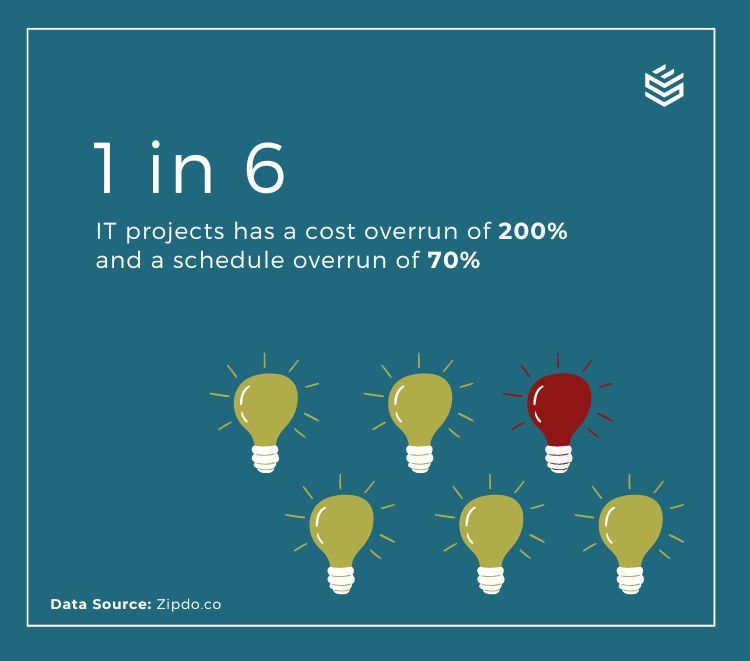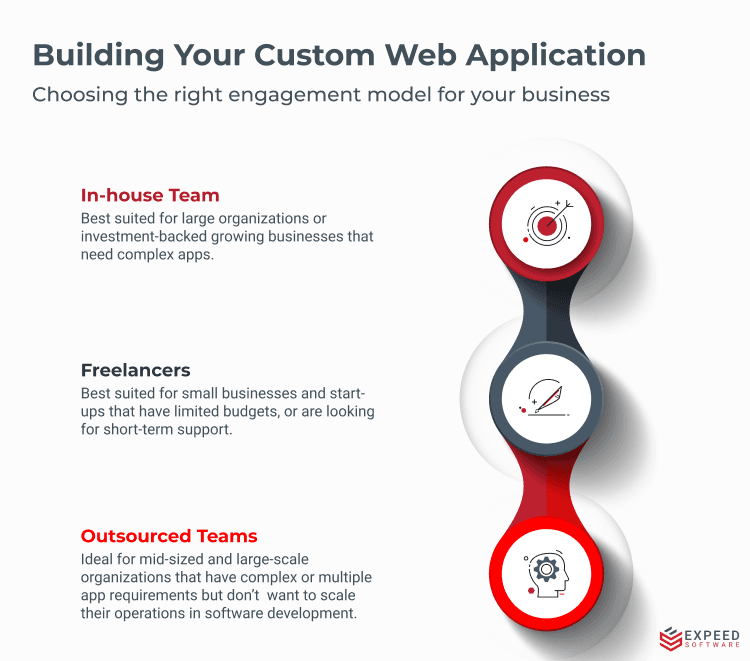Get Your Web App Development Cost Right
In this cybernated world where every business is either launching an innovative digital solution or is on the cusp of transforming its traditional system into a digital platform, custom web application development seems to be the norm. But despite the host of benefits that a custom-built app offers a business, not all cost of custom web application development projects take off successfully.
In fact, global statistics on software projects indicate a high failure rate. Here’s a look at some insights revealed during the recent report compiled by Zipdo on software development project failures –
- 31.1% of software projects will be canceled before they are completed.
- Poor requirements are the leading cause of project failure at 39.03%.
- 32% of IT projects face challenges due to unclear objectives and outcomes.
- 37% of IT projects fail due to a lack of involvement from senior management.

Of course, a custom web application development project could fail due to many reasons, such as the wrong technology for the product, lack of proper implementation support, misguided product research and incomplete market data, weak launch strategy, and more. However, a majority of such software development projects have cited budgetary issues as key reasons for failure. Take a look at these stats from the above report.
- 1 in 6 IT projects has a cost overrun of 200% and a schedule overrun of 70%.
- Over 52.7% of software projects will cost 189% of their original estimates.
- Only 16.2% of software projects are completed on time and budget.
That brings us to the reason why we decided to put this article together – getting your web application development cost right is vital for your project’s success.
How to Plan Your Web App Development Budget
So here’s the big question – why are so many businesses miscalculating their budgets? Obviously, they would’ve spent enough time researching the various cost-bearing factors involved in the product development life-cycle.
Just a simple Google search would return a very comprehensive list of cost-influencing factors such as the scope of the product, cost of the technology stack being used, integrations, deployment strategies, maintenance costs, etc. While they are all very relevant and play a big role when adding up the expenses, they are seldom the reason why projects go off the budget wagon.
The real problem lies in the fact that most businesses ask the ‘how much’ question before the ‘who’ and ‘what’ questions. They try to compare the cost of a similar product in the market, make an allocation, and then try to rope in the custom web application development team and technology that can do the trick within the budget.
The ideal way to go about this would be to first determine who is going to build the web application, identify the skills and tech capabilities of the said team, plan for the best stack that can be delivered and supported by the team, and then make provisions for unexpected costs within the gamut of the team’s environment.
Here’s a step-by-step approach to making a proper estimation of the costs involved in custom web application development.
Hire the Right Custom Web App Development Team
Every business must first determine who is going to be in charge of their custom web application development. The most popular choices for businesses today are:
- Building an in-house development team
- Hiring freelance app developers
- Outsourcing to development teams/companies
All three options come with their own merits and dangers, and the decision depends entirely upon what stage the product owner is in terms of business growth, capital investment, and market share.
But more importantly, the business decision to go with one or the other of these choices plays a big role in determining the cost of a web application development project.

Let’s explore the benefits of each option, see what business conditions make them the best match, and how they all impact the project cost and budgetary expectations differently.
Building an in-house development team
If you’re a large organization, already an established market player with dedicated teams to handle the various operational aspects of your business, and enough capital support, then putting together your own development team might be the best option.
Hiring skilled developers with the right exposure and hands-on tech experience can be very costly, but is the sure-shot way to build custom web applications that work effectively, scale as your business grows, and give you the best ROI.
Below are some of the challenges related to hiring an in-house development team that impact the cost of development.
- Team Salaries: Building in-house teams essentially means you are adding more numbers to your payroll, which will cost you every month. But on the bright side, you are also absorbing your custom web app development maintenance and support costs in the long run. The more technologically complex your application is, the larger and more skilled your team will have to be; which means more salaries. This might not impact large organizations much, but will surely make a dent in the resource allocation of smaller and mid-sized organizations.
- Infrastructure: It is not enough to hire a good team, you also need to equip them with the right tools and technologies. Here, infrastructure refers to both hardware like laptops, remote login keys, etc, and software like development frameworks, licenses, libraries, etc. Investing in infrastructure is the more sensible choice if you have a plan to scale your business in place. In such scenarios, you need to purchase technologies that can support your business as it grows. Opting for low-cost or minimal infrastructure might result in significant additional expenses when the need to upgrade arises.
- Training: Technology is evolving and innovating itself every single day. To keep up with the latest trends, it is important to offer training and development support to your custom web application development teams, so they can deliver the highest quality products and services. This is true even for senior developers. The resource cost of continuous training and development is something a business must factor in, lest they want to end up with obsolete products.
- Expertise Level: When building a web application development team, it is important to get the ratio of senior and junior developers right. Hiring more junior developers because they are less expensive cannot compensate for the expertise and experience that the senior developers were supposed to bring to the table. A ‘high-quantity-low-quality’ approach to hiring would only result in poor budget estimation, missed delivery deadlines, and low-quality products – all of which translate to more expenses in the future.
- Geographical Locations: It’s easy to guess that salaries, infrastructure costs, and benefits vary greatly depending on the geographical location. Development in high-cost areas (like San Francisco or New York) is more expensive than in regions with lower living costs. So, it is only natural that a company operating in a high-cost area sets up another office in a low-cost area to hire a web application development team. However, such organizations must also factor in the cost of collaboration tools and management resources that are required to make distributed teams more effective.
Hiring Freelance Web App Developers
Clearly, adding an entire team of developers to the payroll is not an option for small businesses that want a good quality product. For these businesses, the option is to hire freelance developers who match their required expertise and skill level. This solution is best suited for start-ups who want to get their initial product built and launched in the market, and also for growing businesses that are looking for short-term development support.
Below are some of the budgetary oversights that are most likely to happen when hiring freelancers, that have the potential to derail your project.
- Expertise Level: If the custom web application you’re building is complex, you want to have a highly skilled freelance developer working with you. The more skilled, qualified, and experienced the developer is, the more they are going to charge you. But it would be an investment in the right direction, as these developers will be able to deliver high-quality work efficiently. The cost of the developer directly impacts your custom web application development cost. However, going for less experienced freelancers to save money can cost your business more in the long run. Due to the freelancers’ lack of experience with certain technologies or complex project requirements, the project may face significant delays and require additional resources to address quality issues or redo parts of the application
- Local Market Rate: The cost of freelancing will vary depending on the cost of living expenses in various geographical locations that these developers are located in. It is more sensible for a business that is running in a low-cost area to avoid freelance developers who may be located in high-cost areas. In this specific case, a higher pay rate does not necessarily mean more experience or capabilities.
- Cost-sharing Terms: Bringing clarity to the terms of cost-sharing is very important for the success of any custom web application development project that involves freelancers. In order to ensure complete ownership of the product at project completion, most businesses bear the cost of all software infrastructure, including development tools, licenses, and subscriptions. But there are also times when the freelancers are already in possession of certain tools and subscriptions and would ask the company to bear only usage costs. An unambiguous cost-sharing agreement is crucial for ensuring that your business does not end up paying for hidden costs and expenses in the end.
- Unclear Delivery KPIs: A successful web app development project is measured on many factors, such as milestones, quality standards, and deadlines, metrics that are more effectively tracked and monitored in professional team setups. When working with freelance teams, this is seldom achieved. Freelance developers tend to focus more on delivery timelines and app functionalities than anything else. The result may be work that fails to meet the business expectations in terms of quality and user experience, leading to additional development costs.
- Lack of Control on Delivery Timelines: Finally, the biggest cost-influencing bottleneck that businesses associating with freelancers face – the lack of control in implementing timelines. The fact that most freelance developers work on multiple projects at a time aggravates the availability issue. And let’s face it – missed delivery deadlines equals losses for the business. Even if you decide to hire a dedicated freelancer who is paid for all his time leading up to project completion (a highly expensive affair), or you anticipate delays and keep a buffer time between the proposed launch and the actual launch date, the fact still remains that as a business you will have very limited control over their actual work hours, processes, and time allocation of freelancers.
Outsource to Application Development Companies
When you don’t want to risk working with freelance developers and you’re not big-pocketed enough to hire the best developers for the job, the best option is to outsource your custom web application development project to a third-party company. It is a solution that offers you the best of both worlds – get a dedicated team of experts working for your product from initial design, to MVP, to launch and support, without investing in full-time employee salaries and benefits, infrastructure, or man management.
Yes, you can have your cake and eat it too.
But as was the case with the other two scenarios, here too your project can go off-budget if not planned and executed properly. Below are some budget-influencing considerations when outsourcing your web app development.
- Project Complexity: As we can see, project complexity remains a common factor in all three scenarios. The more feature-rich your application is, the more experienced your assigned team will have to be. Furthermore, if you’re looking at tight deadlines, your outsourcing partner will assign a larger team so that all deliveries happen on time. All of this translates to more costs. But on the brighter side, your project gets completed on time and you can start generating revenue sooner. The important thing is to have a proper discussion with the web application development company so that they are aware of your expectations right from the start and make provisions for allocating the right team for you.
- Technology Stack: The choice of technology stack affects both the initial development cost and the long-term maintenance costs of your custom web application development project. Some technologies require more specialized expertise or are less common, which can drive up costs due to the higher demand for skilled developers. While deciding on the tech stack, talk to your outsourcing partner about the less common technology stack to avoid. This will save you from higher costs for ongoing maintenance and support.
- Experience and Reputation of Company: When a lot is riding on the performance and quality of the custom web application, you want to work with the best in the industry who can give your product a competitive edge. However, the experience and reputation of a custom web application development company significantly impact the overall cost of your app development project. The service charges are directly proportional to their expertise and position in the marketplace. This might be a small price to pay if you cannot compromise on the app’s performance and quality standards.
- Geographic Locations: Finally, the geographic location of the web application development company can also influence the cost due to differences in living expenses, tax rules, talent pool availability, and regional employee salary-scale differences. While outsourcing to development companies based in low-cost areas might be financially beneficial, businesses need to make sure that the company has the right expertise, credibility, track record, and a professional project management system in place. An oversight in making these essential validations can lead to bad development experiences and poor-quality applications.
Optimizing Costs Vs Results in Web App Development
The challenge in any custom web application development is to find the right balance between minimizing costs and maximizing results, without risking project completion. This balance is crucial because overly focusing on cost reduction can lead to a subpar product that fails to meet user needs or business goals, while solely focusing on results without regard to cost can lead to budget overruns and financial strain on the project or organization.
Some effective strategies for cost optimization are:
- Agile Development Practices: Continuous evaluation of the project at regular intervals to make the required adjustments along the way.
- MVP Approach: Creating a Minimum Viable Product (MVP) that can be tested for real-world applications before moving on to final development.
- Cost-Benefit Analysis: Analyze the benefit of each feature or functionality of the web application against the cost incurred to develop it, in order to make informed decisions.
Custom Web Application Development at Expeed
At Expeed, we follow an Agile methodology to develop high-performing web and mobile applications for our clients worldwide. We bank on our 15 years of experience and our team of highly skilled developers to create beautiful digital products that can connect with your customers and perform seamlessly as you scale. Apart from custom web application development, we also offer mobile app development, enterprise software development, and digital transformation consulting.
If you’re looking for a reliable and reputed technology partner for your web app development project, speak to our team today.




